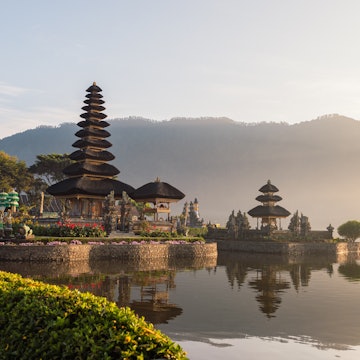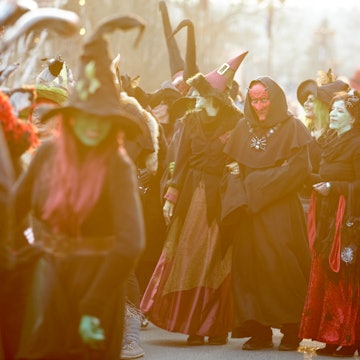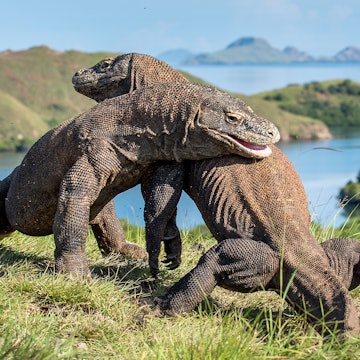

While climate change has altered weather patterns in Indonesia, there’s something fantastic to see in this exciting country every season of the year. Yusnizam Yusof/Shutterstock
Not too long ago, Indonesia had but two uncomplicated seasons: wet and dry. But then climate change teamed up with El Nino and La Niña to turn the weather upside down.
These days, given these unpredictable weather conditions, it can be a little trickier to pinpoint exactly when the perfect weather will happen in this vast archipelagic nation. Yet, wacky forecasts or not, one thing remains true: there’s never a bad time to visit Indonesia.
Of course, more factors are in play than just the weather. Many travelers are more interested in the best time to catch a perfect wave, climb a volcano, or hang out with orangutans and whale sharks. And for some, it's all about beach parties and colorful festivals, or avoiding crowds. That's a lot to consider – but don't worry.
Whether you’re drawn to the surf or the sand, the jungles or those fabulous festivals, here’s our guide on the best times to visit Indonesia.

The high season (July–August, Christmas and New Year’s Eve) is the best time to visit Indonesia for beaches
The Indonesia peak season falls during the sweet spot of July and August, when perfect sunny weather coincides with the European summer holidays and the Australian winter, bringing a surge of tourism across the archipelago. If you don’t mind the crowds, this is a lively time to visit. Bali and Lombok are especially pumping, with packed beaches and bars. This is also the prime time for trekking, surfing, diving and outdoor wilderness adventures in most areas – with the exception of West Papua and Maluku, which see heavy rains in July and August.
All the fun of Indonesia’s peak season comes with the downsides of crowded surf breaks, crammed tourist attractions, swarming trails and nightmarish traffic, not to mention soaring room rates and airfares. To avoid paying the highest rates, you’ll need to pre-book months in advance. The Christmas holidays are another time when you can expect tourism and prices to ramp up as the peak of peak season sets in.

The shoulder season (March–June and September–November) is the best time for natural encounters
With a winning mix of superb weather, reduced tourist numbers and lower prices, the shoulder-season periods at either end of the peak season are our favorite times to visit Indonesia. Though you may get some rain (especially in March and November), you’re more likely to see nothing but glorious sunshine.
Everything seems to click at this time. The waves are great, orangutans are out feeding in the jungles of Sumatra and Kalimantan, and divers head out in search of big-name visitors such as whale sharks and mola mola (sunfish), which gather from June to September. The shoulder seasons are also great times for scaling Indonesia’s volcanoes: expect optional trekking conditions without the throngs of tourists.
So, what are the downsides of shoulder season? Occasionally, you'll get some smoke-haze pollution from farmers burning off fields and areas of cleared forest in Sumatra and Kalimantan from September to November. If you have any respiratory issues, this is something you'll need to take into consideration.

The low season (January–February) is the best time for bargain prices
Ah, the wet season...two words visitors never want to hear, especially those hoping for sun, surf and sand. Yet through Indonesia is undeniably humid at this time – and your hair is bound to get a little frizzy more than once – the rainy season doesn’t mean it’s going to bucket down for the entirety of your trip. Instead, expect short, intense downpours before the blue skies reappear and the sun starts shining again like it never happened.
During the wet months, tourist numbers plummet, which brings a more relaxed vibe and discounts across the board. Traveling in the off-season is a great time to immerse yourself in local culture and visit temples across Java and Bali without the usual crush of tourists. It’s not a good time if you’re planning on hiking, however, with most volcanoes off-limits from December to March. Orangutans and other wildlife can also be harder to spot in the rainy months.
If you’re seeking somewhere less rainy, West Papua and Maluku experience their dry season at this time of year. If you’re into hiking to remote villages or diving into the unparalleled reefs of Raja Ampat, these are the best months to visit. Not only is the ocean calm, but visibility is crystal clear, offering perfect conditions for exploring this spectacular underwater world.

When is the best time to visit Bali?
For many tourists, Indonesia means Bali, and there are definitely optimum times to visit this legendary holiday island. Things are just about perfect at either end of the peak tourist season, from May to June, and throughout September. Not only can you enjoy sublime beach weather, legendary waves, stunning volcano treks, thundering waterfalls, yoga retreats, and fascinating Hindu culture, but you'll also get to experience it all without the jostling crowds. As an added plus, you won't have to worry about booking months in advance, and you can save money compared to peak season prices.
Will traveling in the rainy season ruin my vacation?
If you're seeking a chilled-out holiday and enjoy getting a good deal, then a rainy-season trip to Indonesia is well worth considering. Sure, you'll get some downpours from December to February – some of them heavy – but that doesn't mean it's going to be wet around the clock. Instead, expect a few hours of rain, often in the afternoon, before the blue skies reappear, and you can be back by the pool, cocktail in hand. But if you've got your heart set on trekking, diving, surfing and wildlife encounters, it's best to schedule your trip during the drier (and busier) months from April to October.














